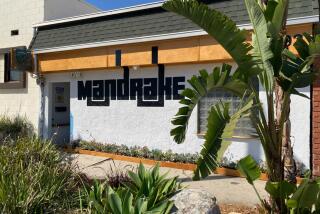Del Monte offers intoxicating taste of history
Long ago before the Venice boardwalk was a messy hive of sunglass huts, homeless hipsters begging for weed and a prime example of what happens when T-shirt slogans go terribly wrong, it housed an elaborate promenade of stunning luxury hotels and was known as the Coney Island of the Pacific. Developer Abbot Kinney had also master planned opera houses, ballrooms, bathhouses and a grand pier.
Every roaring ‘20s playground needed a boozy respite, and Venice had a bar established in 1915 called Menotti’s Buffet. When Prohibition put the “un” in fun in early 1920, owner Cesar Menotti took his liquor business downstairs, turning a basement storeroom into one of the city’s most famed speak-easys. Late last year, that basement room was finally reopened as a subterranean parlor known as the Del Monte Speakeasy.
With three nights of live music booked by Sly Stone’s daughter, musician Novena Carmel; a killer comedy show; and a sexy burlesque night, the Del Monte has caught its stride and is becoming known as one of the Westside’s best choices for a craft cocktail and first-class diversion (Feist, members of the Mars Volta and Mayer Hawthorne have played there, among others).
“I think we’re the only venue in L.A. that can say we were a functioning venue during Prohibition,” says head bartender and mixologist Brandon Ristaino, who has created a well-rounded list of seasonal craft cocktails for the Del Monte, and helped open a number of popular bars, including the Thirsty Crow and the Bigfoot West. “And we’re bringing back the spirit and craftsmanship of that era.”
The sense of history the Del Monte emits is intoxicating — it throws the passing years into stark relief with a wink, a nod and a well-made Old Fashioned. You can picture the kinds of people who hung around its smoky tables in the 1920s — the politicians, the players and the entertainers — and you wonder what they drank and how they spoke.
The Del Monte thrives directly downstairs from the Townhouse, which was the original Menotti’s Buffet and had, until current owner Louie Ryan took it over in 2007, gained quite a reputation for being a house of ill repute.
“This was known as a tough bar, I can’t sugarcoat it,” says Ryan, who nonetheless saw the potential of the place — enough so that he was willing to fight a lengthy permitting battle to reopen the Del Monte even though it had been used as a bar and live music venue many times before (the neighboring Hotel Irwin claimed to be worried about noise from the bar). He also had to tend to complaints voiced by Anjelica Huston’s husband, the sculptor Robert Graham. Graham and Huston lived across the street from the bar and Ryan says Graham was very concerned about noise.
“He basically wanted to privatize the whole street,” says Ryan, adding that after Graham passed away in 2008, Huston called a meeting. “As soon as we met and she heard my Irish accent it was just fine. We never heard from her again.”
Ryan is sitting downstairs at the Del Monte with Ristaino at an old circular wooden table covered with about an inch of resin. The soft orange glow of the table-side lights illuminate a pressed tin ceiling and the many wood accents that make the room feel so cozy and East Coast.
None of the decor is original. As so often happens in L.A. with places that have been fortunate enough to exist for nearly a century, the room had been torn apart. All that remained of its notorious history as the main Westside distribution hub for illegal Canadian whiskey and rum were the stories told by old-timers. There were the believable — whiskey was run to the bar through underground utility tunnels from caves and catacombs below the pier; and the not-so-believable — a long tunnel connected the Del Monte to King Eddy’s Saloon in downtown Los Angeles.
Ristaino says he’s heard there was a room below the Del Monte that has been cemented in.
“An old gentleman came in and insisted that he used to go down there into the ‘fight club,’” says Ristaino, grinning. The history of the place always gets him fired up, especially because it pairs so nicely with his passion for making clean and classic cocktails, which at the end of the day is what the bar is really about.
“It’s a fairly blue-collar bar — a working man’s pub,” says Ristaino. “So we do craft cocktails in a very gentle way. Some people use mixology as a blunt instrument to hit people over the head with. But we keep it simple.”
More to Read
The biggest entertainment stories
Get our big stories about Hollywood, film, television, music, arts, culture and more right in your inbox as soon as they publish.
You may occasionally receive promotional content from the Los Angeles Times.







